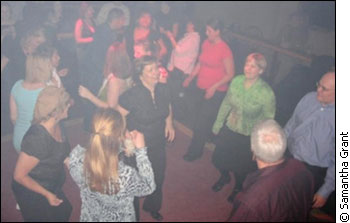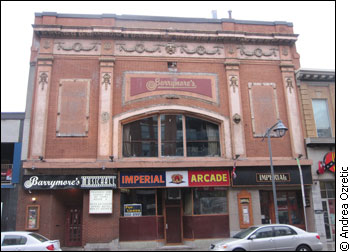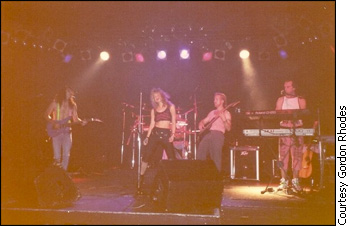Tags
Related Posts
Share This
Barrymore’s: dead and walking?

Grey power: The dance floor on an ’80s-request Sunday night.
Tipsy twenty-somethings, decked out in Wayfarer sunglasses, fanny packs, neon nylon windbreakers and fishnet stockings, bop to all-request ’80s music atop a stage. Middle-aged Ottawans sway side-to-side or bop equally, to music they’ve requested, from what may be the decade to which their twenties belonged. This is Barrymore’s Music Hall and its clientele on a Sunday night, better known as ’80s Night.
To those swaying side-to-side, I pose a question: Do you happen to be reminiscing about the good old days at Barrymore’s? Though it now draws a crowd only on Sundays, Barrymore’s at its height did not need a nostalgia night to attract people.
Opened as a disco in 1977, Barrymore’s quickly transitioned and was a rock ’n’ roll club by 1979. Throughout the ’80s, Barrymore’s was known as Ottawa’s answer to New York’s Studio 54 and was host to such legendary acts as U2, B.B. King, R.E.M., James Brown, Tina Turner and the Tragically Hip.
Today Barrymore’s faces all the challenges of a modern nightclub, but is also regarded as an important space that holds many memories for people in Ottawa. Yet despite such strong public sentiments, Barrymore’s has consistently been unable to recapture its 1980s buzz. Even the building—an architectural marvel nearly a century old, formally known as the Imperial Theatre—now shows a weathered façade, deemed an eyesore by many.

The Barrymore’s Bank Street exterior embodies faded glory.
The venue has undergone several ownership changes since 1991. Owners have included Eugene Haslam (the man behind Ottawa dance club Zaphod Beeblebrox) and then Randy Lanctot. During the ’90s Barrymore’s still had big-name acts like Radiohead, Bo Diddley and The Commitments. The venue was also used for CD release parties. Allan Wigney, a journalist currently working on a book about the music scene in Ottawa, says that Lucinda Williams’s performance at Barrymore’s in 1998 was the last big act he recalls there. During the late ’90s and early 2000s, there were local bands with original music performing, but eventually it became more and more cover bands. Wigney attributes the decline of original music at Barrymore’s to Haslam’s departure in 1999.
The most recent change happened when Montreal-based club owner Vince Simeone purchased Barrymore’s from Randy Lanctot in August 2008. Business at Barrymore’s hasn’t been bustling, and opinions of its latest owner have been lacklustre.
“Without a visionary kind of ownership, it lost its way. New owners who are from out of town, they have tried to put into place the tried-and-true ‘We’ll put in the formula disco night or themed disco night,’ ” says Denis Armstrong, Ottawa Sun entertainment columnist.
“You have a lot of very interesting people who live in Ottawa, a lot of creative and dynamic people, but the city needs to have places where these people can collect and socialize,” Armstrong adds.
Gord Rhodes ran the club from 1978 to 1991 together with his wife, Sherry Rhodes, and her father, Sonny Thomson. Gord is primarily attributed for bringing in the acts.
“I just told them, ‘You’re playing Montreal one night, and two nights later you’re playing Toronto, and you got all these other days off. Why waste your time? Come and do two shows in one night,’” said Gord.

The scene in the good old days.
Sherry Rhodes says they had a great team in the office. Bob Jones came in during the later years as the promotions manager. Sherry describes Jones as having “a pure white Mohawk with pure white extensions that went down to his waist.”
“We had three generations of music between us.” Says Sherry, “ Gord was the ’50s and ’60s: he’s a few years older than me. I was the ’70s, and Bob was the ’80s and ’90s.”
She describes her dad, Sonny Thomson, as the night keeper, there to make sure everything ran smoothly. He once saved Canadian legend (and Guess Who veteran) Burton Cummings from being attacked onstage. Cummings signed an autograph for Thomson that night: “Dear Sonny, thanks for keeping me out of the hospital.”
Despite the acts and the crowds that Barrymore’s was able to bring in, the business still had its challenges. “We didn’t have a lot of capital. We would lose money, win on others. We took some big losses; we were never in a really comfortable position,” said Sherry.
‘Without a visionary kind of ownership, it lost its way.’
– Denis Armstrong
Gord says that larger organizations like the NCC and the Jazz and Blues Festivals had larger backings that made it hard for him to compete. He says that he would break the acts into Ottawa’s scene and lose money doing it, and when it was time to bring them in again and make a profit, the festivals would offer the acts big money to play at a free outdoor concert.
“It’s not a fair business at all; I was very fortunate to be able to do as good as I did,” said Gord.
“If I had the chance I would take it [Barrymore’s] back because I think my husband, Gord, was the perfect promoter,” said Sherry Rhodes.
A different nightlife
Armstrong describes an Ottawa nightlife that has changed dramatically since the 1980s. He sees ’80s Night at Barrymore’s as a diluted version of the past.
“It’s sort of like the zombie version, because they were dangerous times, risky times, sexually, socially. There was a lot going on—people having sex in the bathroom, people doing coke on the dance floor—and now we don’t even allow smoking in the clubs,” he said.
Gord says the introduction of stricter drinking and driving laws was a detriment to his business: “It wouldn’t work now. Drinking and driving laws, television’s too good, there’s just too much going on.”
Many echo the idea of by-laws as being detrimental to Barrymore’s. Says Armstrong, “You know, people would go to these places to have fun, relax, let their hair down. They don’t want to do it while policemen are hanging over their shoulder, breathing down their neck.”
George Syriannas is a relative of Simeone, and the manager at Barrymore’s. He admits that it has been a challenge for reasons including the by-laws.
“The problem is Barrymore’s can fit 1,000, but the city of Ottawa stepped in here with the by-laws and all these other things over the years, and they said, ‘Stairs, exit this, that, and capacity 420 that’s it, that’s all.’ ” says George Syriannas.
‘People in Ottawa like to complain, but then they don’t man up.’ – George Syriannas
As a result of the lower capacity levels, he says that Live Nation, the company that promotes and book bands at venues, will not book them at Barrymore’s, turning instead to bigger locations. Without the ability to bring in bigger names, Barrymore’s is struggling to attract a crowd.
Also, Syriannas says, people want to see live bands playing their own music at Barrymore’s, but financially Barrymore’s does not benefit from this format. “There are smaller bands and smaller promoters that want to book Barrymore’s, but again it comes down to money. They don’t want to give us any money from the cover.”
Forfeiting cover would not be such a problem if people were spending more at the bar. However, that is not the case, as Syriannas explains.
“Best-case scenario is we put 360 people in here. The average person will spend $10; when you do the math, we sold $3,600 in those two or three hours. Out of that take taxes; take out $1,000 that I need for my staff; take then my cost, and I’m down to nothing.”
Syriannas says the only alternative Barrymore’s can afford is booking cover bands, a popular and successful format used in Byward Market venues. But even this has been a challenge.
He explains that the previous Saturday they widely advertised that Barrymore’s would have a cover band, and that there would be no charge to get in. Fewer than one hundred people showed up.
“People in Ottawa like to complain, but then they don’t man up,” adds Syriannas.
All this contrasts with Barrymore’s in its ’80s heyday. Gord recalls it was not easy back then, either, but they found a way to make it work.
“It was very, very difficult to do it,” says Gord, “getting people to come out and see shows. You know February the 27th; it’s 40 below; we’d have eight or nine hundred people there. It was very amazing. But if you wanted to see the act, you had to come out.”





